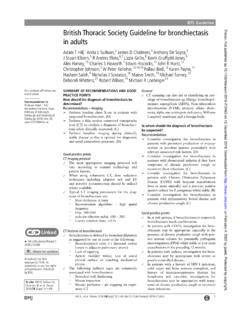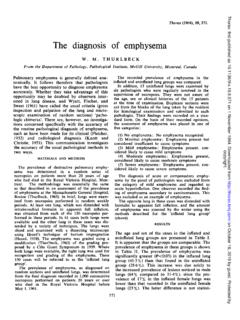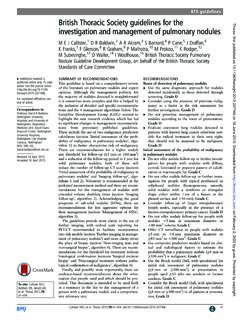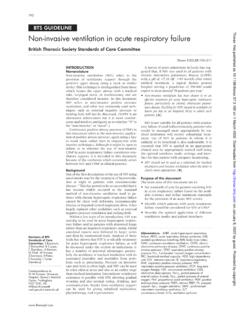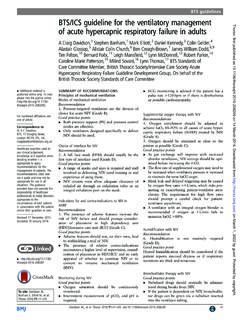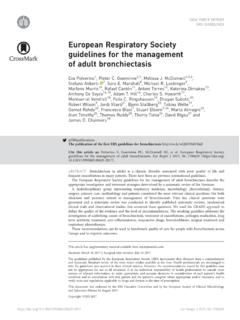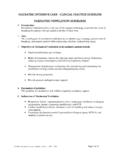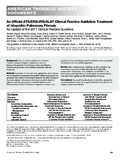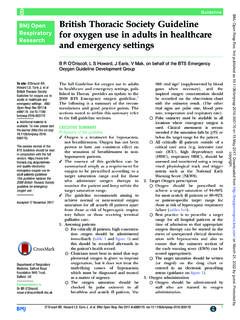Transcription of Interstitial lung disease guideline: the British Thoracic ...
1 Interstitial lung disease guideline: the BritishThoracic Society in collaboration with the ThoracicSociety of Australia and New Zealand and the IrishThoracic SocietyA U Wells,1N Hirani,2on behalf of the British Thoracic Society Interstitial Lung DiseaseGuideline Group, a subgroup of the British Thoracic Society Standards of CareCommittee, in collaboration with the Thoracic Society of Australia and New Zealandand the Irish Thoracic SocietycAdditional information ispublished in the onlineappendices (2, 5 11) at Brompton Hospital, Interstitial Lung disease Unit,London, UK;2 Royal InfirmaryEdinburgh, Edinburgh, UKCorrespondence to:Dr N Hirani, Royal InfirmaryEdinburgh, Little FranceCrescent, Edinburgh EH16 4SA,UK; Interstitial Lung DiseaseGuideline Group Members:A Wells (Co-Chair), B Bradley,H Branley, J Egan (Irish ThoracicSociety), K Harrison, N Hirani(Co-Chair), R Hubbard, A Millar,W Wallace, M Whyte,D Hansell, M Greaves, F Lake( Thoracic Society of Australiaand New Zealand) andM Wilsher ( Thoracic Society ofAustralia and New Zealand)Received 14 May 2008 Accepted 28 May 20081.
2 An overview of the ILD guidelineSince the publication of the first BTS guidelines fordiffuse lung disease nearly 10 years ago,1thespecialty has seen considerable change. The earlydiscussions of the Guideline Group centred uponwhether the revised document might consist of the1999 document with minor adaptations. However,it was considered that too much change had takenplace in the intervening years to justify a simpleeditorial approach. The last decade had seen thedevelopment of a new consensus terminology forthe idiopathic Interstitial pneumonias (IIP)2stimu-lated, in part, by the identification of non-specificinterstitial pneumonia (NSIP) as a discrete histolo-gical pattern with increasingly recognised better prognosis seen in fibroticNSIP than in idiopathic pulmonary fibrosis (IPF)45fuelled a more intense approach to diagnosis incases of suspected IPF. This in turn has led to aradical change in accepted diagnostic gold stan-dards, which have become increasingly multidisci-plinary and dependent equally upon the skills ofpathologists, radiologists and , as anew entity, has posed particular difficulties.
3 Withmore detailed studies of outcome specific toindividual IIPs, especially IPF and fibrotic NSIP,the prognostic weighting given to pulmonaryfunction impairment has been refined, especiallywith regard to longitudinal functional important, with the standardisation ofterminology, it became possible to recruit patientsinto multicentre treatment 10 With regardto IPF in particular, the last 3 years have seen morestudies of treatment than in the previous history ofthe speciality, yet there is no universally accepted best current treatment . Methodology for constructing guidelines andmaking recommendationsThe overall process for generating BTS guidelineshas been addressed in numerous recently publisheddocuments (available at ). The methodology appliedherein is broadly similar and is not thereforedescribed in detail. However, there are specificaspects in the process of writing the ILD guidelinesthat merit are the first BTS guidelines to havebeen written in conjunction with otherinternational bodies, namely the ThoracicSociety of Australia and New Zealand andthe Irish Thoracic Society.
4 It is hoped that, bybroadening the collaborative base, the qualityand credibility of the guidelines has beenenhanced and the document will reach awider readership. Inevitably certain aspects ofthe guidelines for example, delivery of spe-cific healthcare resources are written withthe UK in mind, but may be equally applic-able a very early stage the Guideline Committeecanvassed the views of colleagues (chestphysicians, radiologists and pathologists) viafocus groups. The aim was to determine thespread of opinions with regard to the idealcontent of a new guideline and specificallyon the more controversial aspects of ILDincluding nomenclature, delivery of care andoptimum management in the absence diagnosis and management of commoninterstitial lung diseases but not rare condi-tions are comprehensively addressed inthese guidelines . Conditions such asLangerhan s cell histiocytosis (LAH), lym-phangioleiomoyomatosis (LAM), pulmonaryvasculitis and alveolar proteinosis are beingaddressed by the BTS-endorsed BritishOrphan Lung disease project ( ) comprehensive search of major databases(Medline, PubMed, EmBase and CINAHL)was performed, focusing principally on peer-reviewed articles generated since the publica-tion of the previous guidelines in 1999.
5 Wherepossible, searches were performed in responseto a specific question (eg, What is theevidence that pulmonary rehabilitation isbeneficial in ILD? ). levels of evidence and the grading ofrecommendations are summarised in table grading of recommendations A D will bevery familiar to the reader. However, in thecourse of writing the guidelines it becameapparent that there are many areas of ILDBTS guidelineThorax2008;63(Suppl V):v1 v58. on July 13, 2022 by guest. Protected by : first published as on 24 September 2008. Downloaded from on July 13, 2022 by guest. Protected by : first published as on 24 September 2008. Downloaded from on July 13, 2022 by guest. Protected by : first published as on 24 September 2008. Downloaded from management for which there is, at best, sparse data uponwhich to base recommendations. This is highlighted whereappropriate and should act as a spur for more research. Inother areas such as the management of acute ILD in theintensive care unit or the management of fibrotic NSIP itis clear that controlled clinical trials may never be Committee, based on the discussions with focusgroups, felt compelled to offer some form of guidance inthose areas that impact regularly on clinical practice, areimmensely challenging, but for which there is little or noevidence base.
6 Also, in the course of guideline develop-ment, there has been a discussion in the literature on theusefulness of guideline recommendations for decisions involve a trade-off betweenthe potential benefits and risks, and these decisions need tobe individualised on a case-by-case basis after discussionwith the patient. This model of recommendations isembodied in the GRADE system12in which the quality ofevidence is qualified by strength of recommendation(either weak or strong). This allows, for example, a strongrecommendation to be made even if the evidence base isweak and visa versa. The Committee felt that thisresonated strongly with several management areas in theguideline, best exemplified in the management of IPF. Herethere are examples of discordance between the strength ofrecommendation and level of evidence; interferon-c(IFNc)-1b is not recommended for the treatment of IPF(pending further data) although there is a published meta-analysis suggesting survival benefit.
7 For this reason, someof the statements for the management and treatment ofIPF are qualified where appropriate with a weak or strong are some proposed recommendations in the guide-line that were subject to intense debate within theCommittee and upon which consensus could not beachieved. Again, this is exemplified in the management ofIPF with specific drugs and, in such cases, a final statementwas derived by anonymous voting within the Committee,removing the exercise of undue influence by any singlecommittee the remainder of the introduction the recent keycontentious issues in ILD are considered in turn. A constanttheme that permeates through the entire guideline is thatregional centres are now required to effectively manage ILD, astrong recommendation reached unanimously by the Terminology of Interstitial lung diseaseThe term Interstitial lung disease is synonymous with diffuse parenchymal lung disease and, while the latter wasused in the 1999 BTS guideline, a decision was made to adoptinterstitial lung disease in the current document, consistentwith other international guidelines .
8 A more difficult issue , in the UK, the term cryptogenic fibrosingalveolitis (CFA) corresponds to a characteristic clinicalpresentation seen typically in IPF but common also to manypatients with other idiopathic Interstitial pneumonias and somecases of hypersensitivity pneumonitis. The use of CFA as anumbrella term in the 1999 BTS guideline reflected the fact thatit was not then clear that distinctions between IIP subsets wereof any true clinical value other than the very crude distinctionbetween predominantly inflammatory and predominantlyfibrotic disease ; in short, the historical distinction betweendesquamative Interstitial pneumonia (DIP) and usual interstitialpneumonia (UIP).However, within 2 years of the publication of the first BTSguidelines, a new consensus classification had been proposed bya joint American Thoracic Society (ATS) and EuropeanRespiratory Society (ERS) new ATS/ERSterminology captured outcome differences in a number ofstudies comparing subsets of patients with 4 13 18 Thehistorical outcome distinctions between predominantly fibroticdisease and inflammatory disorders (the latter now expanded toinclude cryptogenic organising pneumonia (COP), lymphocyticinterstitial pneumonia (LIP), cellular NSIP, respiratory bronch-iolitis with associated Interstitial lung disease (RBILD) anddesquamative Interstitial pneumonia (DIP)) were exactly asreported previously.
9 However, the important new outcomesubgroup to emerge was the entity of fibrotic NSIP. Thesepatients made up 20 35% of patients previously diagnosed asIPF or CFA and their long-term survival was substantially betterthan that seen with a histological pattern of UIP. On this basis,the core entity of IPF was redefined: characteristic clinicalfeatures were required in association with a histological patternof UIP at surgical biopsy or a high resolution CT (HRCT)pattern typical of UIP. In addition, the absence of alymphocytosis on bronchoalveolar lavage (BAL) or the absenceof features of an alternative diagnosis on transbronchial biopsywere required in patients not undergoing a surgical biopsy(table 2).19 These non-biopsy ATS/ERS criteria remain theinternationally accepted standard by which to make a diagnosisof IPF in the absence of a surgical lung biopsy. However, forpragmatic reasons, many elderly patients, those with significantco-morbidity and patients seen outside referral centres often donot undergo transbronchial lung biopsy or BAL.
10 The role of BALand transbronchial biopsy is thus currently under ATS/ERS consensus statement explicitly stated that CFAand IPF were synonymous Committee thereforefaced a choice between adopting the ATS/ERS terminology andpersisting with the use of CFA as an umbrella term as used inthe first BTS guidelines . In an initial consultative process inTable 1 Grading system for recommendations11 Levels of evidence1++High quality meta-analyses, systematic reviews of randomised controlled trials(RCTs) or RCTs with a very low risk of bias1+Well conducted meta-analyses, systematic reviews of RCTs or RCTs with a lowrisk of bias1-Meta-analyses, systematic reviews or RCTs or RCTs with a high risk of bias2++High quality systematic reviews of case-control or cohort studies or highquality case-control or cohort studies with a very low risk of confounding, biasor chance and a high probability that the relationship is causal2+Well conducted case-control or cohort studies with a low risk of confounding,bias or chance and a moderate probability that the relationship is causal22 Case-control or cohort studies with a high risk of confounding, bias or chanceand a significant risk that the relationship is not causal3 Non-analytical studies (eg, case reports, case series)
